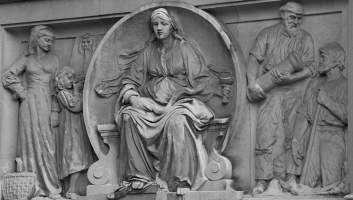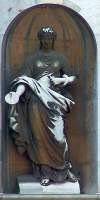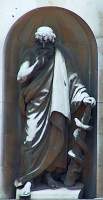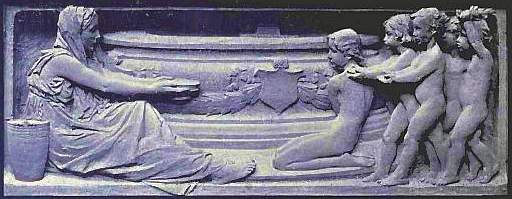
I would have thought there would be lots of allegorical statues of Health, given the Victorian passion for cleanliness and that improved health was seen as both a great success and continuing target for the Government, philanthropists and charities alike. However I have come across only a very few Victorian allegories of Health, less Edwardian, and a few more after World War One.
Above, however is a very excellent Victorian example – Health is a seated female figure in a roundel, holding a cup of water or some healing potion – the symbol of Hygieia – and a serpent – symbol of medicine from the time of Aesculapius – in the other. To the left is a young nurse with a little girl holding a small container, either to drink her medicine, or perhaps to partake of the health-giving water flowing from the spring in the form of a lion’s mouth behind her. The two figures to the right, one with a pipe, the other a pickaxe, would seem to symbolise the delivery of water and sewage by the enlightened municipality, vital for public health. The location is Croydon Town Hall, and the sculptor was E. Roscoe Mullins.
Here is a Hygaeia from the front of Guy’s Hospital, from the late 18th Century, by John Bacon – she is accompanied by a statue of Aesculapius. Again, we have the small bowl, and the snake, here wound about the arm of Hygaeia, and a second one on the staff of the companion figure - more on these statues on on the Borough High Street page.

 Figures of Hygaiea and Aesculapius by John Bacon the Elder.
Figures of Hygaiea and Aesculapius by John Bacon the Elder.
An Edwardian example is the little panel shown below, from the monument to Francis Powell in Mesnes Park, Wigan - he was a Parliamentarian with interests in public health and sanitation. The sculptor was the prolific Ernest Gillick. The figure of Health is shown seated, her arms outstretched, again holding a bowl, with a group of naked infants approaching to receive it.

It should be said that figures of Medicine such as the Aesculapius above by Bacon are rather more common. There are many examples where just the staff with the snake of Aesculapius is present in some composition or architectural sculpture, or there is a procession with one figure of Medicine with the staff. Medicine can be shown as female or male, and the sense is perhaps more of curing sickness than providing health – the distinction is a fine one, and the statue of Medicine on the Albert Memorial is similar in her accoutrements to the Croydon figure of Health above, with snake and bowl, though here the Aesculapius’s snake seems to be actually drinking from Hygieia’s bowl – a nice touch. A similar, though simpler work in stone called Hygieia, by John Cassidy, is in Duthie Park, Aberdeen.
 H. H. Armstead's figure of Medicine.
H. H. Armstead's figure of Medicine.
Back to Allegorical sculpture - G // Onwards to Allegorical sculpture - I // Full Alphabet of Allegorical sculpture
Sculpture in London // Sculpture in England // Sculptors
Visits to this page from 21 Dec 2011: 7,629